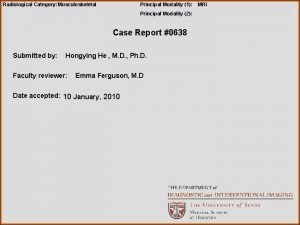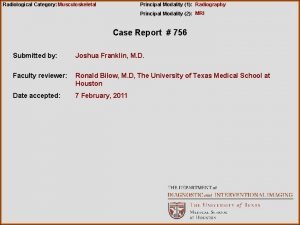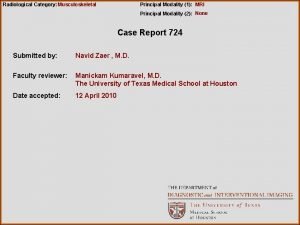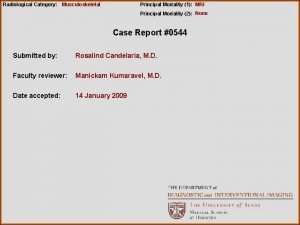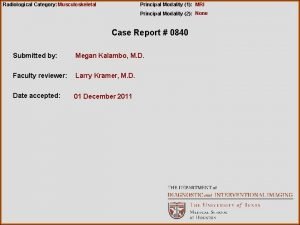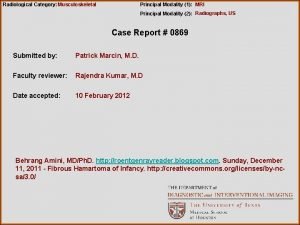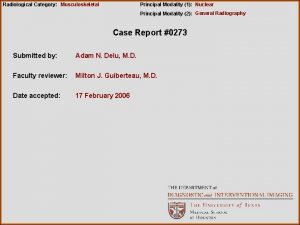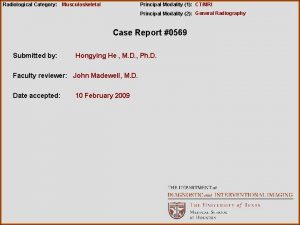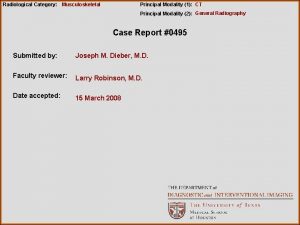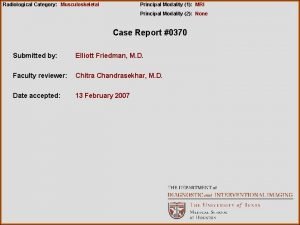Radiological Category Musculoskeletal Principal Modality 1 XRay Principal













- Slides: 13

Radiological Category: Musculoskeletal Principal Modality (1): X-Ray Principal Modality (2): CT & MRI Case Report # 806 Submitted by: Navid Zaer, M. D. Faculty reviewer: Naga Ramesh Chinapuvvula, M. D. , The University of Texas Medical School at Houston Date accepted: 15 March, 2011

Case History A 37 year old otherwise healthy male presents to the ER with a 1 month history of nonspecific epigastric pain radiating to the back. The pain has acutely worsened over the past 3 days. No fevers or chills.

Radiological Presentations: Chest X-ray Bilateral small pleural effusions with fluid tracking along right minor fissure. Mild bibasilar subsegmental atelectasis is also present.

Radiological Presentations: Chest X-ray Bilateral small pleural effusions. Possible inter vertebral disc space narrowing along with ill defined endplates at one of the levels in the lower thoracic spine.

Radiological Presentations: Chest X-ray Adjusting window/level demonstrates a focal bulge of the left paraspinal stripe at the lower thoracic spine.

Radiological Presentations: CT T 8 -T 9 opposing endplates irregularity and erosive changes with adjacent mild pre- and para vertebral soft tissue

Radiological Presentations: MRI T 1 and post gadolinium images demonstrate altered marrow signal and enhancement of the T 8 -9 vertebral bodies along with mild enhancing pre vertebral soft tissue extending from T 7 -T 10.

Test Your Diagnosis Which one of the following is your choice for the appropriate diagnosis? After your selection, go to next page. • Degenerative changes • Osteomyelitis • Vertebral body neoplasm

Findings and Differentials Findings: Chest radiograph demonstrates small bilateral pleural effusions with possible intervertebral disc space narrowing and illdefined endplates at one of the levels in the lower thoracic spine. A focal bulge at the lower left para spinal stripe is also visualized which is subtle. CT demonstrates T 8 -9 opposing endplate irregularity and erosive changes with mild pre- and paravertebral soft tissue swelling. MRI findings reveal altered marrow signal with enhancement of T 8 -T 9 vertebrae. Differentials: • Degenerative changes • Osteomyelitis • Vertebral body neoplasm

Discussion FOCAL DEGENERATION: Although a common cause of back pain, degenerative spondylosis is rarely this focal and would be uncommon in a patient of this age. Intervertebral disc space narrowing is often seen along with vacuum phenomenon, disk dessication, facet arthrosis, and eventual disc herniation. Erosive changes and prevertebral soft tissue changes are not seen. Also diffuse enhancement of the vertebral bodies on post gadolinium MRI and associated soft tissue component makes degeneration an un likely possibility. The acuity of the patient’s pain would also speak towards an alternate diagnosis. NEOPLASM: LEUKEMIA: This is the most common malignancy in children. On MRI, there is homogenous decreased signal intensity on T 1 WI due to replacement of fatty marrow by leukemic cells. Compression deformities of vertebrae can also be seen. Foci of leukemic infiltration display increased signal intensity on T 2 WI. LYMPHOMA: Non-Hodgkin's lymphoma (NHL) accounts for more than 85% of cases of spine and epidural soft tissue involvement. On MRI, Spinal lymphoma is typically hypointense on T 1 and inhomogenously hyperintense on T 2 WI. It often occurs between 40 -60 years of age and would be atypical for our patient. MULTIPLE MYELOMA: This is a monoclonal proliferation of malignant plasma cells that affects the bone marrow. The peak incidence is in 6 th decade. The spine is the most common site and epidural involvement is frequent. Five different infiltration patterns can be differentiated: (1) normal appearance of bone marrow despite minor microscopic plasma cell infiltration, (2) focal involvement (high signal on STIR), (3) homogeneous diffuse infiltration (homogeneous signal reduction on unenhanced T 1), (4) combined diffuse and focal infiltration, (5) “salt-and-pepper”-pattern with inhomogeneous bone marrow with interposition of fat islands.

Discussion OSTEOMYELITIS: Infectious spondylitis is a potential cause of debilitating neurological injury. Most commonly seen in the lumbar>cervical>spine with staph aureus as the most common infectious organism. Radiographic findings in this case are very subtle with possible mild intervertebral disc space narrowing and paraspinal soft tissue as noted in this patient. CT findings demonstrate erosive changes at the endplates and pre/paravertebral phlegmonous soft tissues. Contrast MRI is confirmatory and demonstrates T 2/STIR marrow hyperintensity of the affected vertebral bodies along with enhancement of the vertebrae and the associated soft tissue, post gadolinium. This patient was fortunate to have been examined early in the disease process as no epidural soft tissue/abscess or cord compression was noted. Although this is not a novel entity, the subtle x-ray findings complemented by expected CT and MRI results are an important learning point for the ER radiologist who may be the first clinician to identify a potentially life-threatening condition.

Diagnosis Vertebral Osteomyelitis

References Cottle L, Riordan T. Infectious spondylodiscitis. J Infect. Jun 2008; 56(6): 401 -12. Eguchi Y, Ohtori S, Yamashita M, Yamauchi K, Suzuki M, Orita S, et al. Diffusion magnetic resonance imaging to differentiate degenerative from infectious endplate abnormalities in the lumbar spine. Spine (Phila Pa 1976). Feb 1 2011; 36(3): E 198 -202 Baur-Melnyk A, et. al. Role of MRI for the diagnosis and prognosis of multiple myeloma. Eur. J of Radiology. Jul 2005; 55 (1): 56 -63 Lakhkar BN, et. Al. Pictorial essay: MR appearances of osseous spine tumors. Indian J. of Radiology and Imaging. 2002; 12(3): 383 -390
 Erate category 1
Erate category 1 Radiological dispersal device
Radiological dispersal device Tennessee division of radiological health
Tennessee division of radiological health Center for devices and radiological health
Center for devices and radiological health National radiological emergency preparedness conference
National radiological emergency preparedness conference Epistemic modality
Epistemic modality Birads
Birads Modality stats
Modality stats Modality
Modality Modality in software engineering
Modality in software engineering Entity class in software engineering
Entity class in software engineering Epistemic modality
Epistemic modality Modality in software engineering
Modality in software engineering Cardinality and modality in database
Cardinality and modality in database














